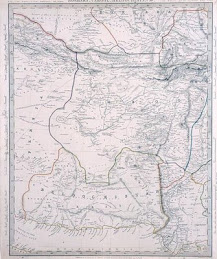The ethnic groups in Iran territorially separated and the ethnic divisions are prominent, the case of ethnically inspired uprising is strong. The classic case is Baluchistan, a region populated with the Baluch people previously was a part of a sovereign state Baluchistan (1872) divided and combined into five Iranian administrated units.
I believe the fundamental ethnic conflict cannot be bridged by Iranian constitutional rewriting, because Iranian has never governed their state by rules of law and constitutional supremacy. The long period of autocratic rules has radicalised the ethnic groups. For these reasons relation between groups and relation between groups and government are unbridgeable.
The movement for an independence Baluchistan has never disappeared. After the 1979 Islamic revolution the nationalist movement was overtake by the religious conflict, between Shiite Zaboli and Sunni Baluch.
Sistan and Baluchistan consist of two groups the Baluch Sunni majority and Zaboli Shiite minority in Baluchistan (Iran is a Shiite majority and bilingual and ethnically divided state) migrant (1904) brought into Sistan in order to reduce Baluch majority in the district of Sistan basin for military and political purpose. Today the province is administrated by minority Zaboli’s and they are over represented in every institution in the province.
The Baluch have no representation in the other four provinces where their land has been merged (1928). The dominance of the Shiite rule and other Persian in Baluchistan has weakened the representation of Baluch by these groups. The state sponsorship, coercion, and appointments to high places worked together to over represent the Shiite Persian. The most over represented people in Baluchistan are Zaboli’s. They are over represented in the security forces as well as judiciary and another economical institution.
Iran is consisted of many rival ethnic groups. But it is dominated by Persian and Turk, to secure the Turk loyalty they are strongly represented in the government institutions and army. To denial ethnic groups’ historical home land the state is carved into small administrated units with consequences that the ethnic groups are deprived permanently from the political power.
The theocratic rule, suppression, will transfer conflict from Baluchistan and Kurdistan region to the state level. There have been tensions over the allocation of resources and other benefits between Turk and Persian in the capital Tehran. The Baluch and the Arab have demanded creation of their own separate states, Kurd and Turk will shift their demand from federalism to an independent. The Kurd and Turk have experienced considerable ethnic tensions against each others.
The Zabolis Shiite minority in Baluchistan have benefited from centrally controlled state structure. Region is populated by large majority Baluch dispersed in the five administrative units with no representation they will fight back the injustices. Considering the Iranian internal and external phenomenon, it is possible for the Baluch to drive back Persian army and control their state. The violence is the product of longstanding Baluch frustration.
The regional autonomy or federalism,
The regional autonomy or federalism is unfair answer to self-determination and statehood. Fear of secession, Widespread a quest for an independent is difficult to dismiss, but federalism is not the answer. Federalism is for the central government to retain ultimate power over the Baluch.
The offer of an autonomy and federalism to the Baluch is possible in order to dismiss Baluch right to statehood and legitimate the occupation of Baluchistan by the Persian and Punjabi army of Pakistan and dispel the Baluch history for ever. The Baluch occupiers are willing to make concessions, only to solidify their power through creating a new central power inside Baluchistan.
The centre of power Pakistan has created in Quetta has failed, if the same attempt would have made by Persian will be unsuccessful. Because the Persian’s are not willing to give the smallest part of the power they have on Baluch away, Persian will revolts against whoever attempts to decentralise the power in Iran. A genuine decentralisation will be very unpopular among the Persian; a decision on decentralisation will fuse the Persian from different parties without risking their constituencies’ seats.
It is possible for the Persian to offer autonomy or federalism based on the character of nationalists uprising, but there is no guarantee, it is acceptable to the Baluch nationalist. Autonomy or federalism will be offered to Iranian ethnic groups after violence will have broken out. The success of secessionists will testify the weakness of Persian central power and fortify the secessionists will to fight on.
Tehran regime may devolve power to region without effect on secessionist. There is also chance that regional autonomy will reduce secessionist sentiment among unwilling secessionist. Federalism is very attractive if it is combined with policies whose effect has raised successful secessionist.
Secessionist is not attractive if it is mean abandonment of opportunities outside the home region. The Persian has opposed the Baluch separatism. The Persian has continued the practice of providing to Shiite villager from the Persian provinces with the opportunities in the administration, securities, business, in Baluchistan, while at the same time expending disproportionate fund on investment in their region in order to force them to settle permanently in Baluchistan.
On the other hand the Baluch population are not spread outside the Baluch region; they are not in lucrative opportunities and investment or the government subsidies that the Baluch would lose if they opted out from Iran. Iranian has failed to take any measure to specific interests that the Baluch have in undivided Iran.
M. Sarjov is a Baluch political activist based in London.










































No comments:
Post a Comment